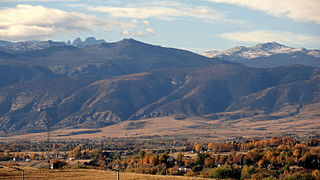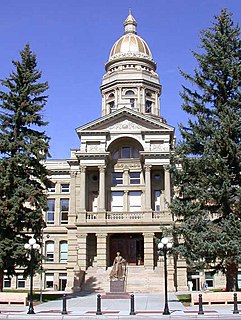
The Wyoming State Capitol is the state capitol and seat of government of the U.S. state of Wyoming. Built between 1886 and 1890, the capitol is located in Cheyenne and contains the chambers of the Wyoming State Legislature as well as the office of the Governor of Wyoming. It was designated a U.S. National Historic Landmark during 1987. The Capitol is currently closed for renovation and is scheduled to reopen mid-2019.

The Charles Fay House is a historic residence in the city of Wyoming, Ohio, United States. Erected in the late nineteenth century, it was originally the home of one of the city's leading educators, and it has been designated a historic site because of its distinctive architecture.

The Luethstrom–Hurin House is a historic residence in the city of Wyoming, Ohio, United States. Erected in the 1860s and profoundly modified before 1875, it was the home of two prominent businessmen in the local grain and flour industry, and it has been designated a historic site because of its architecture.

Oxon Cove Park and Oxon Cove Farm is a national historic district that includes a living farm museum operated by the National Park Service, and located at Oxon Hill, Prince George's County, Maryland. It is part of National Capital Parks-East. It was listed on the National Register of Historic Places in 2003.
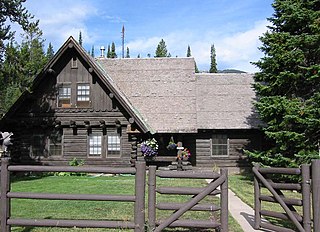
The Old Administrative Area Historic District, also known as Beaver Creek, is the former headquarters area of Grand Teton National Park. The complex of five houses, three warehouses and an administrative building were designed in the National Park Service rustic style between 1934 and 1939 and were built by the Civilian Conservation Corps and the Public Works Administration. As part of the Mission 66 program, the park headquarters were relocated to Moose, Wyoming in the 1960s.
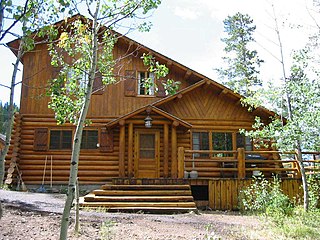
The Brinkerhoff is an historic lodge in Grand Teton National Park on the shore of Jackson Lake. It is the last remaining example of a forest lease vacation lodge in the park. The log house and caretaker's lodge were designed by architect Jan Wilking of Casper, Wyoming and were built in 1946 in what was then U.S. Forest Service land for the Brinkerhoff family. After the creation of Grand Teton National Park, the National Park Service acquired the property and used it for VIP housing. Among the guests at the Brinkerhoff were John F. Kennedy and Richard M. Nixon. The lodge is also notable as a post-war adaptation of the rustic style of architecture. The interior is an intact example of this transitional style.

This is a list of the National Register of Historic Places listings in Sheridan County, Wyoming. It is intended to be a complete list of the properties and districts on the National Register of Historic Places in Sheridan County, Wyoming, United States. The locations of National Register properties and districts for which the latitude and longitude coordinates are included below, may be seen in a map.

The Bishop House in Casper, Wyoming was built in 1907. It was listed on the National Register of Historic Places in 2001.

Buffalo Bill - The Scout, a bronze statue of a mounted rider outside the Buffalo Bill Historical Center in Cody, Wyoming, was placed in 1924 to commemorate the town's most famous resident and de facto founder, Buffalo Bill Cody. Originally in open land on the western outskirts of Cody, the statue today stands at the end of Sheridan Avenue, the town's main thoroughfare, as the town has grown to the west. The project was initiated by Cody's niece, Mary Jester Allen, who had established the basis of what would become the Buffalo Bill Historical Center. A New Yorker, she persuaded heiress and artist Gertrude Vanderbilt Whitney to sculpt the piece.

The Downtown Cody Historic District is the historic core of Cody, Wyoming, USA. "Historic" here refers to the early twentieth century, as Cody was not incorporated until 1901. Most of the commercial district was built between 1901 and the 1930s. The district extends along Sheridan Avenue for two blocks, with buildings of brick and local sandstone with storefront display windows. The chief building in the district is the Irma Hotel, individually listed on the National Register of Historic Places.

The Stock Center in Cody, Wyoming was built in 1927 as the original home of the Buffalo Bill Museum, serving in that purpose until the museum was relocated to a new complex across the street. The log structure is intended to suggest a stockman's log cabin, rendered on a large scale.
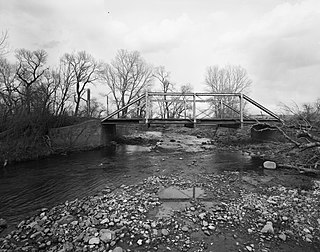
The ECS Bridge over Big Goose Creek is a bridge near Sheridan, Wyoming that was built in 1914. It is a Pratt pony truss bridge which was built by the Canton Bridge Company of Canton, Ohio. The Canton Bridge Company built four steel bridges in Wyoming in 1914; the ECS Bridge is the only one of these surviving in its original location. It is 50 feet long and 15 feet wide.
Leon C. Goodrich was an American architect of Casper, Wyoming. A number of his works are listed on the National Register of Historic Places.

The ECR Kooi Bridge is a bridge in Sheridan County, Wyoming, located 2.7 miles (4.3 km) west of the community of Monarch. The bridge carries Sheridan County Road CN3-93 across the Tongue River. Contractor Jack Gregg built the bridge in 1913. The single-span pin-connected Pratt pony truss bridge is 81.6 feet (24.9 m) long with an 80-foot (24 m) span; it is the longest bridge of its type still in use in the Wyoming state and county highway system. The bridge's roadway was constructed with wooden stringers and decking; its guardrails are also wooden. The pin-connected Pratt pony truss was a common type of truss bridge in Wyoming, and the Kooi Bridge was one of the earlier bridges to use the design.

Trail End, also known as the John B. Kendrick Mansion, is a historic home located at 400 Clarendon Avenue in Sheridan, Wyoming. The home was built and inhabited by Wyoming governor and U.S. Senator John B. Kendrick. Built from 1908 to 1913, the house was designed by William MacAlister and cost $160,000. Kendrick was a successful cattleman when he commissioned the house, and he was only beginning his political career; once he became governor in 1914 and a senator three years later, Trail End became his summer home. The house is typical of homes built by prosperous Wyoming cattlemen in the early 20th century. It was added to the National Register of Historic Places on February 26, 1970.

The EBF Bridge over Powder River is a bridge located near Leiter, Wyoming, which carries Sheridan County Road CN3-269 over the Powder River. The 201.5-foot (61.4 m) bridge has two spans; the first span is a Pratt through truss, while the second span is a Warren truss. Due to this configuration, the bridge has been called "one of [Wyoming's] more interesting vehicular trusses". The trusses in the bridge are connected rigidly rather than by pins; the bridge was built in a transitional period between the two designs and is an early example of rigid connections. The Gregg & Stout Bridge Company of Sheridan built the bridge in 1915.

Fort Steele, also known as Fort Fred Steele, was established to protect the newly built Union Pacific Railroad from attacks by Native Americans during construction of the transcontinental railroad in the United States. The fort was built in 1868 where the railroad crossed the North Platte River in Carbon County, Wyoming. Work on the fort was carried out by military and civilian labor. Fort Steele was one of three forts built on the line. Fort Sanders near Laramie and Fort D.A. Russell at Cheyenne were the other railroad forts. Fort Steele was named for the recently deceased General Frederick Steele.
Susan Ellen Wissler, born Susan Ellen Frisby, was the first female mayor in Wyoming and one of the first in the United States. Wissler was born in Broadhead, Minnesota; she moved to Denver at age nine, where she ultimately married and had two children. In 1890, Wissler and her family moved to Dayton, Wyoming. Wissler's husband died of tuberculosis in 1896, leaving Wissler to support her family alone; she became a local schoolteacher and later opened a millinery store.
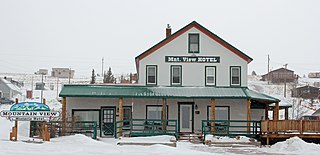
The Mountain View Hotel is a historic hotel near Centennial, Wyoming. It was built in 1907 as the railroad arrived in Centennial in the declining years of a gold mining boom. The hotel was part of a community development plan to develop businesses that did not depend on mining. featured 20 rooms and three baths, but the bathrooms were originally located in a separate stable building. The hotel was bought by Gustav and Anna Sundby in 1914, who operated the hotel into the 1940s. In the 1950s the hotel became an apartment house.

